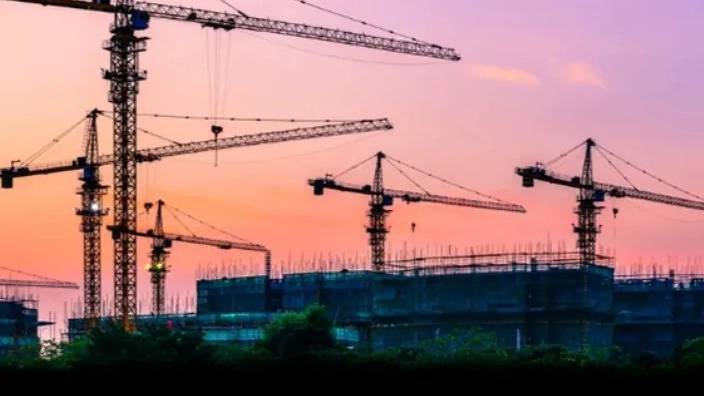What is Crane Tower?
Tower crane is a type of machine that is used to lift, lower and move heavy or bulky construction materials around. Tower crane is a vital component in the construction of tall buildings, huge structures and complex projects. This device is made to control and guide heavy equipment at heights. Tower cranes must be carefully designed to perform at their best and be safe.
✔️ Crane Tower Applications
Tower crane or construction crane has wide applications and in general, the work of this device is to move materials and guide heavy equipment in structures that are very high. Tower cranes are mainly used in the following cases:
Industries, power plants and factories
Residential, office and commercial constructions
High-rise constructions
Dams
Bridging

✔️ Types of Crane Tower
Tower crane or tower crane has different types. Tower crane types include the following:
Sarchekshi
Self-installer
pocket loafing
In a
Tower cranes are generally either fixed or mobile. The fixed construction crane is used daily, and the height increase and the possibility of moving the equipment in this device are limited. Mobile tower crane, however, has a wide operating range that can be used in different parts of the project.
The mobile tower crane itself is divided into three models: rail, road and floating, each of which has advantages and disadvantages. The rail tower crane moves on the rail, and the road tower crane is more like a crane and its dimensions are small. One of the advantages of the road tower crane is that it has a quick installation and low carrying capacity is one of its disadvantages. The floating tower crane is another model of these devices that is used for the purpose of constructing oil mines and taking out sunken ships.

✔️ Serry crane
In a construction crane, the origin of a long horizontal arm is connected to a vertical tower. One end of the arm extends horizontally across the work area, while the other end carries counterweights. Also, a load wheel that holds the lift cable moves along the arm to help move the equipment. This type of tower crane usually needs a second crane for assembling and disassembling parts at the workplace.
ما
Loafing construction crane is another common type of construction tower crane. This crane is recognizable because of its diagonal arm that extends from the top of the mast (tower) at an angle. Unlike Sarchekshi tower crane, in jib luffing, the hook point is at the end of the arm.
Tower crane counterweights are placed closer to the tower when combined with a diagonal arm; As a result, the pocket luffing usually has a higher capacity compared to the overhead crane. Unlike the hammerhead crane, the diagonal arm can move inward and outward (from vertical to 30 degrees angle). This type of movement allows the luffing pocket tower crane to operate in small spaces, which is why this type of tower crane is often seen in dense urban construction environments.
✔️ Drake crane
Derrick tower construction crane is similar to the luffing arm type and its dimensions are designed to be installed on roofs or small spaces. This type of small tower crane is mainly used to assemble or disassemble parts of tower cranes. The derrick tower crane is often without an operator's cabin and is controlled remotely by wire or wireless.
✔️ Installation of Crane Tower
In terms of installation model, tower cranes are divided into two categories: self-installing and assisted installation:
✔️ self -installed crane tower or suicide
The installed tower crane has its own generator and engine, which gets its propulsion and installation power from this part. The self-installing tower crane can be deployed and used alone without the need for a second crane. This advantage in tower crane reduces the setup time and saves project costs. It should be mentioned that another economic point in construction is choosing a concrete or metal frame, because the cost of a metal frame will be higher.
Some models of this type of crane have an operator's cabin, but most self-erecting cranes are controlled from the ground. This type of tower crane is usually independent and can be equipped to move in the work environment.
✔️ Crane tower installed or stretching assistant
This tower crane takes its kinetic energy from an external source, or electricity. Its dimensions are large and it is used to move heavy and large objects at heights. This model does not have the ability to move the load automatically, and the load is transported by a special transport system.
✔️ Tulcorine components
The tower crane is usually placed and fixed using the foundation in a part of the construction site. The general components of the tower crane are:
Battalion
gear
Carriage or Chariot
Arm restraint cable
the hook
Control room
tow wire
Anchor mounting base
Mast or tower
The foundation reinforcement platform
Front arm or arrow
Balancing arm
Cable drum
✔️ The benefits of building crane
Tower cranes make the most difficult execution operations for construction projects easy. They are able to move long and heavy steel beams. If you need more information about the price, you can inquire about the price of the day. Carrying construction materials, concreting the structure, transferring heavy equipment and many other things are among the capabilities of tower cranes.
Tower cranes make it possible to build tall buildings in very tight urban spaces. Also, high speed, lower cost and efficiency are the advantages of using tower crane. Another advantage of using this device is the reduction of labor costs, because using a tower crane reduces the need to hire more people.

